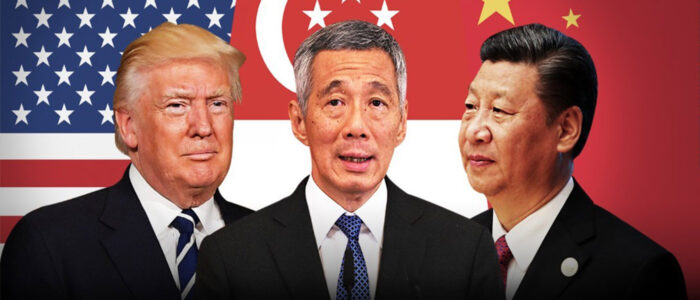In May 2019, the Singaporean Prime Minister Lee Hsein Loong while speaking at the Shangri-La Dialogue called on both the United States (US) and China to reach a strategic accommodation and limit their growing hostility. He maintained that if the trade disputes are resolved purely based on their own merits, then the negotiators on the two sides will be able to move beyond the impasse. However, if the trade rules are used to “keep the other down” then the unfolding consequences will be grave, he stated. Undoubtedly, a small country such as Singapore finds itself in a tight spot in the US-China rivalry and is deeply enmeshed in finding a balanced approach to abstain from choosing sides.
Singapore’s desire to adapt to the external environment and find its positioning in the international arena rests on three predominant ideas. Firstly, the country seeks to increase its relations with like-minded countries to maintain its freedom of action as a sovereign state. Secondly, it aims to further the principle of balance of power in the region to restrict any major power domination. Thirdly, it seeks to maintain the presence of the US in Southeast Asia to ensure regional stability. According to Singapore, the undertaken stance also safeguards the interests of other countries, including China. This approach resultantly leads toward getting external powers, mainly the US, in ensuring the security of the island. The current approach adopted by Singapore over the years has proved advantageous for the country. Particularly, the idea of not aligning with any of the major powers has naturally evolved over the course.
Singapore finds itself in a tight spot in the US-China rivalry and is deeply enmeshed in finding a balanced approach to abstain from choosing sides.
It is important to highlight that Singapore sees the economy as a major component of security, and hence the position of neutrality aids the country on all its fronts. In 2003, the first Asian country to sign a bilateral free trade agreement with the US was Singapore. The agreement came into effect a year later, mainly focused on enhancing trade relations. With regards to the foreign direct investment (FDI), Singapore holds the second-largest stock of the US, and at the same time, the US enjoys a trade surplus with the republic. In the military realm, the two countries signed a Memorandum of Understanding (MOU) in 1990. Their defence relationship stems largely from this MOU and is further facilitated through the 2005 Strategic Framework Agreement and the 2015 US-Singapore Enhanced Defence Cooperation Agreement. As per the Strategic Framework Agreement, Singapore was designated as a “Major Security Cooperation Partner” by the US. The country also provides access to the US Navy ships and military aircraft that is seen as a contributing factor in ensuring the stability and security of Southeast Asia. Annually, Singapore sends approximately 1,000 personnel to the US for training and education courses. The above agreements of partnership speak volumes of the interests at play.
Singapore sees the economy as a major component of security, and hence the position of neutrality aids the country on all its fronts.
In contrast, a close partnership exists with China and is Singapore’s biggest trading partner. In 2017, Singapore was the second-largest foreign investor in China which greatly demonstrates the economic interaction between the two countries. Moreover, in 2019 multiple agreements covering trade and security, including the Belt and Road Initiative (BRI) projects were signed between the two states. High-level ministerial consultations in the form of the Joint Council for Bilateral Cooperation, occur annually. Singapore has also collaborated in the development of three projects in China which include, the Suzhou Industrial Park, the Chongquing Initiative, and Tianjin Eco-city. Reportedly, in 2003 Singapore turned down the offer set by the US to become a non-NATO ally which again signifies the balancing approach that Singapore continues to maintain between the US and China. In 2018, Prime Minister Lee criticized the Trump administration for imposing unilateral tariffs on China which had an impact on Singapore’s economy. “A trade war between the two largest economies in the world will have a big, negative impact on Singapore,” Lee stated in the Washington Post. The reduced shipping caused by the trade war directly impacted Singapore as its GDP in 2019 grew only by 0.7%, its lowest annual trajectory in a decade.
The Southeast Asian countries will continue to employ the combinations of hedging, balancing, and bandwagoning.
Predictably, Singapore does not intend to be a part of any countervailing coalition that might jeopardize its interests. While speaking to the Washington Post in September 2019, Mr Lee Hsein Loong stated that the US’ allies and partners are “deeply enmeshed” with China, and forcing the countries to dissociate themselves from Beijing would be a “challenging strategic stance to make”. The statement puts into perspective the overall picture of how Singapore responds to the ensuing US-China competition. The country clearly articulates its stance, providing no leeway to any ambiguities or scepticism. The Southeast Asian countries will continue to employ the combinations of hedging, balancing, and bandwagoning. Lastly, not choosing between the two countries is a choice in itself. However, the unpredictability of the international system might render the search for finding a balance more elusive.
